A commercial tomato is harvested 20 to 30 days before peak ripeness.
- It’s sent to a distribution center, sorted, and shipped to the store after a few days.
- It sits in the store for who knows how long before being purchased.
- Even then, it may need a few more days to ripen.
This process can take over a month. No wonder store-bought tomatoes taste so bland, waxy, and lifeless compared to ripe tomatoes picked fresh off the plant!
Tomatoes picked at peak ripeness are more nutritious, juicier, sweeter, and have better texture and flavor. It’s tempting to eat them unprepared, like a peach.
So why aren’t we all growing our own tomatoes at home? For many people, the answer is space. But what if you could grow tomatoes in some of the smallest porches and kitchen areas?
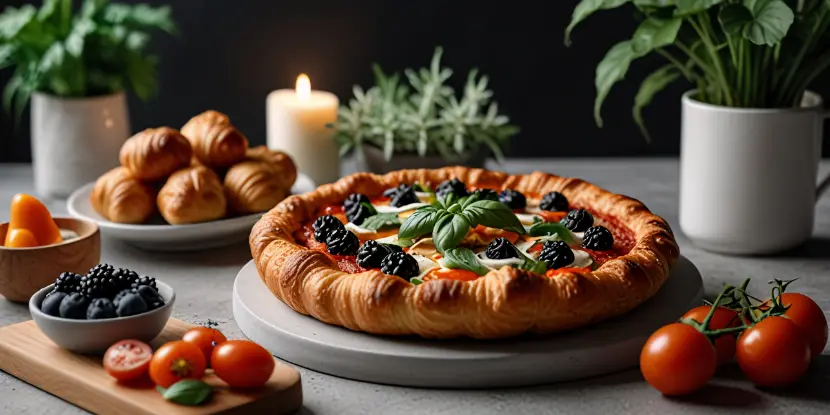
Pizza with berries and basil? It looks delish!
Benefits of Growing Tomatoes in Pots
- Container gardening takes advantage of vertical space and makes the most out of small areas. You can place container-grown tomatoes on balconies, patios, rooftops, or even windowsills.
- You can move container-grown tomato plants to follow the sun or protect them from harsh weather conditions.
- Container gardening reduces the chances of soil-borne diseases and pests because you replace the potting mix every year.
- You have complete control over the soil quality and pH and can customize it according to your tomato plant’s needs.
- You can extend the growing season by bringing tomato plants indoors or placing them under protective cover.
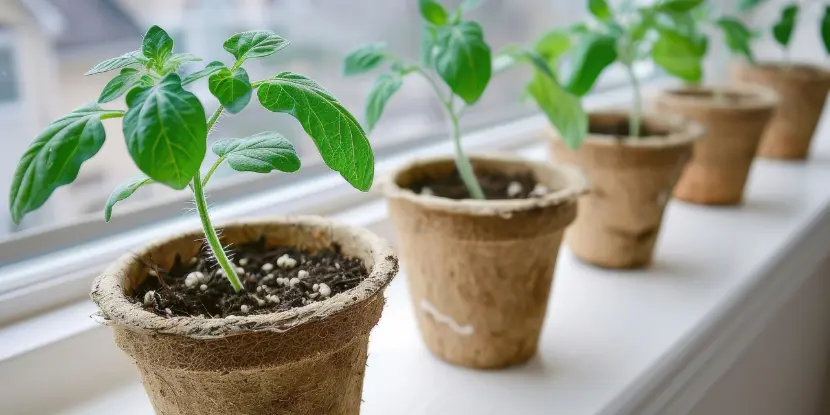
Tomato seedlings growing in peat containers.
Best Tomato Varieties for Containers
Not all tomato varieties are suitable for container gardening. Here are some of the best choices:
- Cherry Tomatoes: ‘Tiny Tim,’ ‘Patio Princess,’ and ‘Tumbling Tom’ are compact and prolific.
- Grape Tomatoes: ‘Sweetheart of the Patio’ offers small, sweet fruit for snacking.
- Determinate Varieties: ‘Bush Early Girl’ and ‘Celebrity’ have a bushy growth habit, making them ideal for containers.
Select a variety with compact growth habits, minimal care requirements, and abundant yields.
Most Heat-Tolerant Tomato Varieties
In areas with intense heat, like Central California, choosing heat-tolerant varieties can make a big difference. Options include:
- Heat Wave II: Hybridized to set fruit even in high temperatures.
- Solar Fire: Bred to withstand scorching summer days.
- Phoenix: Another excellent hot climate variety with consistent harvests.
- Sun Gold: This hybrid cherry tomato is coveted for its flavor and heat tolerance.
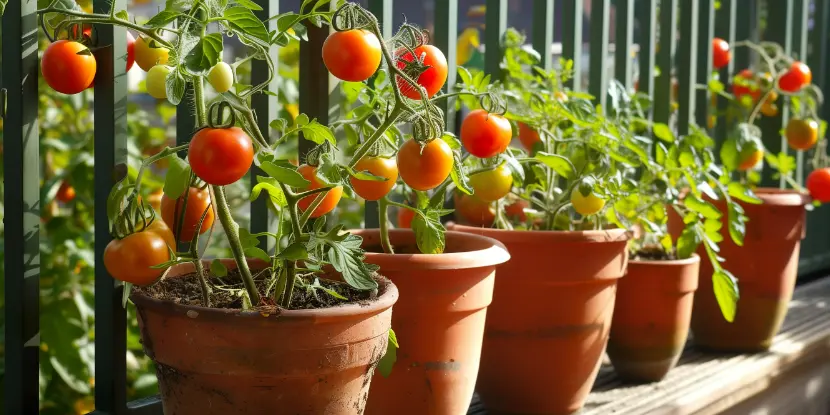
Potted cherry tomato plants on a sunny bench.
Choosing Your Pot or Container
- A container should be at least 18 inches in diameter and 24 inches deep to accommodate the root system.
- Plastic, ceramic, terracotta, and fabric pots are popular choices. The container should have drainage holes to prevent waterlogging. Plastic and ceramic retain moisture longer than porous materials like terracotta.
- If you plan to move your plants around, choose containers made of lightweight materials or equipped with wheels.
- Consider self-watering containers if you have a busy schedule or live in a hot climate.
Soil
Tomatoes need well-draining, nutrient-rich soil.
- Use a high-quality potting mix designed for vegetables.
- Add compost or organic matter to enrich the soil.
- Maintain a pH level between 6.2 and 6.8 for optimal growth.
Sunlight Requirements
- Tomatoes are sun-loving plants. Give them at least 6–8 hours of direct sunlight daily.
- Place containers in a south-facing location for maximum sun exposure.
- Rotate containers periodically to ensure even light distribution.
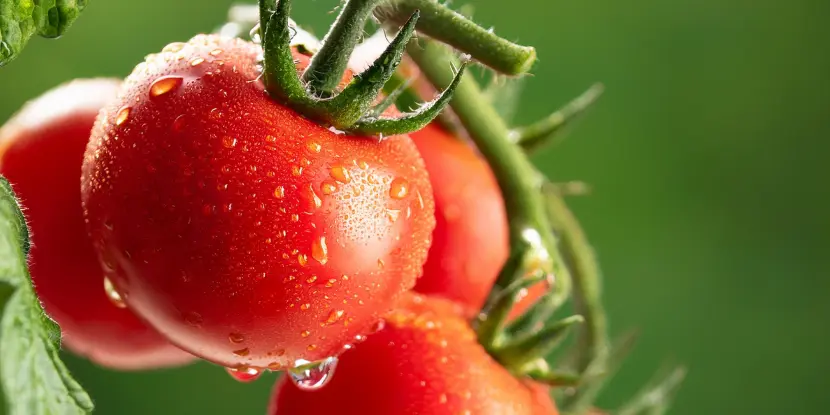
Ripe tomatoes ready for harvest.
Water & Fertilizer
- Keep the soil evenly moist but not soggy. Water deeply in the morning to limit evaporation.
- To promote fruiting, apply a balanced fertilizer or one higher in phosphorus every 2–3 weeks during the growing season.
- Add a layer of mulch to retain moisture and regulate soil temperature.
Pests & Diseases
- Watch for aphids, whiteflies, and tomato hornworms. Use insecticidal soap or neem oil to control infestations.
- Prevent fungal diseases like blight by ensuring good air circulation and avoiding overhead watering.
- Grow companion plants like basil or marigolds near your tomatoes to deter pests naturally.
Hydroponic Tomato Gardening
Many commercial tomatoes are grown hydroponically in greenhouses. This method offers several advantages:
- Hydroponic tomatoes can be grown year-round, regardless of climate or season.
- Nutrient solutions provide plants with the exact nutrients they need for optimal growth.
- Hydroponic systems use less water than soil-based methods.
You can build your own hydroponic system at home or buy one equipped with all the supplies to get you started. Some systems are compact enough to fit on a kitchen counter or a shelf under a grow lamp.
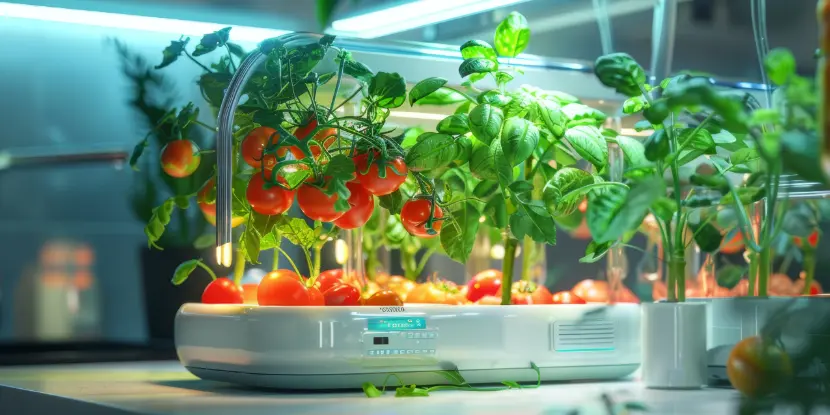
Tomato plants growing hydroponically.
Vertical Tomato Gardening
Vertical gardening is a method of growing plants on a living wall rather than in horizontal beds. The garden can have wall-mounted panels, trellises, or frames to support plants growing skyward.
A vertical garden optimizes space, increases air circulation, and makes harvesting more convenient.
- Trellises and Stakes: Support indeterminate varieties with sturdy structures.
- Hanging Baskets: Ideal for cherry or grape tomatoes, saving ground space while adding a decorative touch.
- Wall Planters: Utilize vertical wall space with specially designed planters.
FAQs: Growing Tomatoes in Pots
Q: Can I grow tomatoes indoors?
Yes. Choose dwarf varieties and give them adequate light from a sunny window or grow lights.
Q: How often should I water my potted tomatoes?
Water when the top inch of soil feels dry. Consistent moisture is the key to preventing issues like blossom end rot.
Q: Do tomatoes need support in containers?
Most varieties benefit from stakes, cages, or trellises to support their growth and keep the fruit off the ground.
Q: What is the best time to plant tomatoes in containers?
Plant your tomatoes after the last frost date in your area. Typically, this is late spring, although you can plant much earlier in Southern California.
Q: Should I prune my container-grown tomato plants?
Pruning can promote better airflow and reduce disease risk. Remove suckers — the small shoots that develop in the leaf axils — to focus the plant’s energy on fruit production.
Q: How can I tell my tomatoes are ripe?
Ripe tomatoes exhibit vibrant color, feel slightly soft, and have a sweet aroma. Look for even color throughout the fruit. It should pull away easily from the plant.
Q: Can I use regular garden soil in containers?
Regular garden soil may compact in the container and retain too much moisture. Use a high-quality potting mix designed for container gardening.
Q: What should I do if my tomato plants are wilting?
Wilting can indicate underwatering or overwatering. Check the soil moisture — water thoroughly if it’s dry several inches down. If the soil is soggy, improve drainage and allow it to dry before watering again.
Q: How do I encourage more fruit production on my tomato plants?
Give your plants adequate sunlight, water consistently, and apply a fertilizer high in phosphorus during the flowering stage.
Q: Are there any specific pests I should watch out for when growing tomatoes in containers?
Yes, common pests include aphids, spider mites, and whiteflies. Regularly inspect your plants and employ organic pest control methods, such as insecticidal soap.

